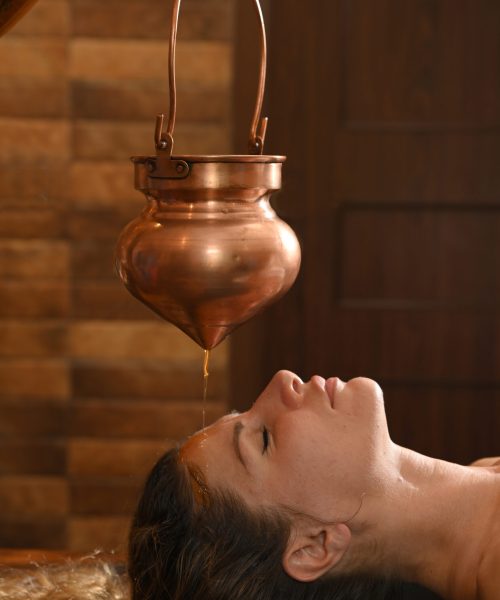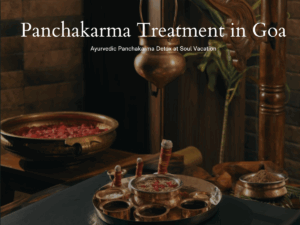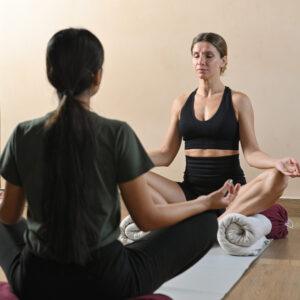Panchakarma, a cornerstone of Ayurvedic medicine, is a comprehensive detoxification and rejuvenation therapy designed to cleanse the body of toxins and restore balance. But what exactly is Panchakarma? And how did it come to be?

What is Panchakarma?
Panchakarma translates to “five actions” or “five treatments,” referring to the five primary therapeutic procedures aimed at detoxifying the body. These procedures are designed to eliminate toxins from the body, strengthen the immune system, and restore balance to the mind, body, and spirit.
Historical Background of Panchakarma
Rooted in ancient Indian tradition, Panchakarma dates back over 5,000 years. It is mentioned in classical Ayurvedic texts like the Charaka Samhita and Sushruta Samhita, where it is described as an essential therapy for maintaining health and preventing disease.
The Five Therapies of Panchakarma
- Vamana (Emesis Therapy): Vamana involves therapeutic vomiting to eliminate toxins from the respiratory and gastrointestinal tract. This treatment is especially beneficial for individuals with Kapha imbalances.
- Virechana (Purgation Therapy): Virechana is the process of cleansing the intestines through therapeutic purgation. It helps in expelling toxins from the liver and gallbladder, providing relief from Pitta disorders.
- Basti (Enema Therapy): Basti is considered the mother of all treatments due to its wide range of applications. It involves the introduction of medicated liquids into the colon to cleanse and nourish the intestines. There are various types of Basti, each tailored to specific health needs.
- Nasya (Nasal Administration): Nasya therapy involves administering medicated oils or powders through the nasal passages. It is highly effective in treating conditions related to the head, such as sinusitis, migraines, and neurological disorders.
- Raktamokshana (Bloodletting Therapy): Raktamokshana, or bloodletting, is used to remove impure blood from the body. It is beneficial for treating skin conditions, hypertension, and other blood-related disorders.
The Science Behind Panchakarma
Ayurvedic Principles
Panchakarma is based on the principles of Ayurveda, which emphasizes balance among the body’s three doshas: Vata, Pitta, and Kapha. By removing toxins and restoring dosha balance, Panchakarma promotes optimal health.
How Panchakarma Works
The therapies involved in Panchakarma work by first loosening the toxins (Ama) in the body, then flushing them out through the digestive and excretory systems. This process rejuvenates the body’s tissues and enhances the functioning of the immune system.
Benefits of Panchakarma Treatment
Physical Benefits
- Detoxifies the body
- Improves digestion
- Enhances metabolism
- Boosts immunity
- Promotes weight loss
Mental and Emotional Benefits
- Reduces stress and anxiety
- Improves sleep quality
- Enhances mental clarity
- Balances emotions
Detoxification and Rejuvenation
Panchakarma is a powerful detoxification process that removes accumulated toxins from the body, leading to rejuvenation of the body’s systems and a renewed sense of vitality.
Who Can Benefit from Panchakarma Treatment?
Ideal Candidates
Panchakarma is suitable for anyone looking to detoxify their body and restore balance. It is especially beneficial for those experiencing chronic illnesses, stress, or lifestyle imbalances.
Conditions Treated
- Digestive disorders
- Respiratory problems
- Skin conditions
- Hormonal imbalances
- Autoimmune diseases
Preparation for Panchakarma Treatment
Pre-Treatment Guidelines
Preparation for Panchakarma involves following specific dietary guidelines and lifestyle changes to ensure the body is ready for detoxification.
Dietary Recommendations
A light, easily digestible diet is recommended before undergoing Panchakarma. Foods that are fresh, organic, and free from preservatives should be consumed to aid the cleansing process.
The Panchakarma Treatment Process
Initial Consultation
The process begins with a detailed consultation with an Ayurvedic practitioner, who will assess your health and determine the appropriate treatments.
Customizing the Treatment
Based on the consultation, a personalized Panchakarma plan is created, tailored to your specific health needs and dosha imbalances.
The Duration of Treatment
The duration of Panchakarma varies depending on individual needs and the type of treatments prescribed. It can range from a few days to several weeks.
Panchakarma Treatment Procedures, Benefits & Precautions
1. Vamana: Emesis Therapy
Procedure
Vamana involves administering herbal preparations that induce vomiting to cleanse the stomach and respiratory tract.
Benefits
- Removes toxins from the stomach and lungs
- Improves respiratory health
- Balances Kapha dosha
Precautions
Vamana should be performed under the supervision of a qualified Ayurvedic practitioner to ensure safety and effectiveness.
2. Virechana: Purgation Therapy
Procedure
Virechana involves the administration of herbal laxatives to cleanse the intestines and liver.
Benefits
- Detoxifies the liver and gallbladder
- Alleviates Pitta-related disorders
- Enhances digestion
Precautions
Proper preparation and post-treatment care are essential to avoid complications during Virechana.
3. Basti: Enema Therapy
Types of Basti
- Anuvasana Basti (Oil Enema)
- Niruha Basti (Decoction Enema)
Procedure
Basti involves introducing medicated oils or decoctions into the colon to cleanse and nourish the intestines.
Benefits
- Detoxifies the colon
- Nourishes and rejuvenates tissues
- Balances Vata dosha
Precautions
Basti should be customized based on individual health needs and administered by a trained practitioner.
4. Nasya: Nasal Administration
Procedure
Nasya involves the application of medicated oils or powders into the nostrils to cleanse and nourish the nasal passages and sinuses.
Benefits
- Clears sinuses and nasal passages
- Improves respiratory function
- Enhances mental clarity
Precautions
Nasya should be performed under the guidance of an experienced practitioner to ensure proper administration and effectiveness.
5. Raktamokshana: Bloodletting Therapy
Procedure
Raktamokshana involves removing a small amount of blood to eliminate toxins and improve circulation.
Benefits
- Treats skin conditions and blood disorders
- Reduces hypertension
- Enhances overall health
Precautions
Raktamokshana should be performed in a controlled environment by a qualified practitioner to ensure safety.
Post-Panchakarma Care
Post-Treatment Guidelines
Following Panchakarma, it is important to follow specific dietary and lifestyle guidelines to maintain the benefits of the treatment.
Dietary and Lifestyle Changes
A balanced diet, regular exercise, and stress management practices are essential for maintaining the results of Panchakarma.
Modern Adaptations of Panchakarma Treatment
Integrating Panchakarma with Modern Medicine
Many wellness centers and spas now offer Panchakarma treatments, integrating traditional Ayurvedic practices with modern medical approaches for holistic health.
Panchakarma in Wellness Centers and Spas
The popularity of Panchakarma has led to its incorporation into various wellness programs, providing people with accessible ways to experience its benefits.
Conclusion: Panchakarma Treatment
Panchakarma is a powerful and transformative Ayurvedic therapy that offers numerous physical, mental, and emotional benefits. By cleansing the body of toxins and restoring balance, Panchakarma Treatment promotes optimal health and well-being.
FAQs: Panchakarma Treatment
Panchakarma is a traditional Ayurvedic detoxification and rejuvenation therapy that includes five main procedures designed to cleanse your body of toxins and restore balance.
The five main procedures are:
Vamana (therapeutic vomiting)
Virechana (purgation)
Basti (medicated enema)
Nasya (nasal administration of medications)
Raktamokshana (bloodletting)
If you’re looking to detoxify your body, improve overall health, manage chronic illnesses, reduce stress, or enhance mental clarity, panchakarma treatment can be beneficial for you. It’s tailored to your specific needs and conditions.
The duration of Panchakarma treatment varies depending on your individual needs but typically ranges from 7 to 21 days.
While you can perform some preparatory and post-treatment practices at home, the main panchakarma therapies should be done under the supervision of a qualified Ayurvedic practitioner.
Panchakarma is generally safe, but it’s important to consult with a qualified Ayurvedic practitioner before starting. Certain conditions or health issues may require modifications or specific precautions.
Preparation treatment usually includes dietary adjustments, herbal supplements, and lifestyle changes recommended by your Ayurvedic practitioner. Following these guidelines will help you achieve the best results.
During panchakarma, you’ll experience a combination of therapeutic procedures, dietary regimens, and relaxation techniques aimed at cleansing your body, improving digestion, and rejuvenating your mind and spirit.
Panchakarma is generally safe when performed correctly, but it may cause mild discomfort or detox symptoms such as fatigue or mild digestive issues. These are usually temporary.
Yes, panchakarma can aid in weight loss by detoxifying your body, improving metabolism, and promoting healthy digestion. It’s often part of a holistic approach to weight management.
Your diet will typically be light and easy to digest, focusing on fresh, organic, and warm foods. Your Ayurvedic practitioner will provide specific dietary guidelines for you to follow.
It’s recommended to undergo panchakarma once or twice a year, depending on your health needs and lifestyle.
Panchakarma can be customized for individuals of all ages, but it’s essential to consult with a qualified practitioner to ensure the treatments are appropriate.
It’s best to take time off from strenuous activities and work during Panchakarma to allow your body to rest and rejuvenate. Gentle exercises like yoga and meditation are encouraged.
The cost varies based on the treatment center, duration, and specific procedures involved. Inquire directly with the Ayurvedic center or practitioner for accurate pricing.
The long-term benefits include improved digestion, enhanced immune function, reduced stress, better mental clarity, and overall rejuvenation. Panchakarma helps maintain balance and harmony in your body and mind.
Read More: wikipedia | vikaspedia








